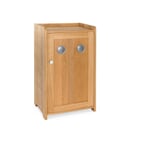Bread cupboard westphalian

Bread cupboard westphalian
- Thought-out: optimal internal climate for longer-lasting bread
- Traditional bread cabinet grill: iron ventilation fittings tinned
- Additional ventilation: bottoms shortened to the front
General Information
This cabinet is modeled after a historical original with nothing to improve: Ventilation fittings in the doors and shelves shortened towards the front allow fresh air to circulate inside, which suits the storage of bread, fruit and vegetables. Its ancestral place may have been the kitchen, but the cabinet also cuts a fine figure elsewhere, for example as a buffet table in the living room. He is made for us in a Westphalian carpenter's workshop.
True farmer shrewdness.
"Wat de Buur nich kennt, dat frett he nich", is the saying in Westphalian Low German, a proverb that we will politely translate at this point as "What the agricultural economist does not know how to identify, he does not take". As with many proverbs, there is probably a grain of truth in this one as well, but it would be inappropriate to want to recognize a provincialism worthy of ridicule in the attitude it describes. For those who believe this, the cabaret artist and writer Oliver Hassencamp adds: "If city dwellers knew what they ate, they would immediately become farmers. Whether the Westphalian farmer in particular was or is particularly fussy about his choice of food remains to be seen. But he has always been a farmer when it comes to storing his provisions and, like his colleagues in other regions, he has always been imaginative in doing so. For example, the "Brautschapp", which bears its most noble task already in its name: It is the bread cupboard that kept the bread supply fresh and edible from one (usually weekly) baking day to the next. Its internal climate also ensured that other foodstuffs such as fruit and vegetables could be stored for a long time. Finally, such a bread cabinet also testifies to the practical sense of the peasantry in that the cabinet is not alone cabinet: the top typically provides a convenient work surface for the preparation of the supplies stored therein.
Historical furniture, timeless.
Our "Brautschapp" comes - how could it be otherwise - from a Westphalian furniture carpentry in the Münsterland and is based on a hardly to improve historical original. This concerns not only the construction as such, but also the selection of the processed woods as well as the craftsmanship approach. The fact that it is also an unagitatedly beautiful piece of furniture that can be integrated into a wide variety of living environments is plain to see. His ancestral place may have been the kitchen or the courtyard hallway, but no doubt he makes a good figure elsewhere, for example, as a buffet table in the living area or in the conservatory.
Ventilation and pine.
The most striking feature of the bread cabinet are the two ventilation fittings (the carpenter speaks of bread cabinet grilles) set into the right-hinged cabinet door. They ensure that fresh air is constantly circulating through the inside of the cabinet. To allow this to happen across the entire interior even when the door is closed, the shelves are slightly shortened toward the front of the cabinet.
However, the thoughtful air circulation is only the first design idea aimed at thoughtful food storage. Another is the choice of woods. The fact that the cabinet's side panels and door frame are made of oiled oak, while the back panel and shelves are made of untreated pine, has a food-related twist. Because many domestic wood species have an antibacterial effect - and this applies in particular to the untreated pine wood.
The cabinet in detail.
The side panels are made of solid oak and oiled with hard wax oil. They have a material thickness of lush 26 mm, which gives the cabinet great stability. The feet are milled out of the side panels; at the top, like the overlying cabinet top, they have a 4.5 cm projection at the back, creating a 57 x 42 cm work surface with railings bordering three sides. The two-part door frame is also made of solid oiled oak, the door panels are made of cross-laminated oak veneer. Here the material thickness is 20 mm. The door fitting is a tenon hinge made of iron - more complicated to install than usual hinges, but so stable and dimensionally stable that the door closes permanently even without a snap lock. Back panel and shelves are made of 19 mm thick untreated pine wood. The shelves - two "whole" and one extending over half the interior surface of the cabinet - can be inserted in 6-cm increments via a toothed pine strip. Open and close the bread cabinet with the help of a round porcelain furniture knob from our range.
Product Information
Article Number 15112
- Thought-out: optimal internal climate for longer-lasting bread
- Traditional bread cabinet grill: iron ventilation fittings tinned
- Additional ventilation: bottoms shortened to the front
Body of oiled oak (origin Eastern Europe), back panel and shelves of untreated pine (origin Poland). Ventilation fittings (bread cupboard grille) of tinned iron, Ø 10 cm. Door knob porcelain, Ø 35 mm. Made in Germany. Body height 110 cm, width 62 cm, depth 45 cm. Shelves width 56.5 cm, depth 19 cm (half) or 37 cm (full). Worktop top 57 × 42 cm. Weight 41.5 kg.
Have a question?
If you have a question concerning this product you are welcome to contact us. For this your E-Mail program will open.
Contact Us
For advice, spare parts or special requests - our customer service will take care of your questions and concerns, personally and competently.
You can reach us from Monday to Friday at +49 2309 939095 or anytime at info@manufactum.com
Manufactum
Discover our home brand: We have developed products for you; good things that we have long wished for, but have not been able to find on the market. For lack of alternatives, we have launched choice goods that meet both your and our quality standards.
Explore our home brand


